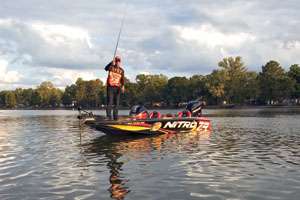
When bass stack up on river ledges in summer, Greg Hackney knows he might have to finesse finicky fish into biting. But there's nothing dainty about his tackle or his approach. When times are right, Hackney hauls out the heavy metal — a big, heavy metal spoon.
Hackney compares his style of spoon fishing to working a big single-spin, which often is the choice of anglers seeking big bites from specific fish. The action of the single blade thumping along a ledge triggers bass that have been feeding on gizzard shad or suspended off the ledge or point.
He feels the same way about the spoon, which in today's bass fishing world isn't the pinky-size spoon of old. Today's models often are 5 or 6 inches long, at least an inch wide, thin and slightly concave, and affixed with large, heavy-duty treble hooks.
The intent, if you could call it that, is power fishing with a touch of finesse. "It's almost like throwing a big single-bladed spinnerbait. I can feel everything it's doing," Hackney said. "It's for when bass are situated on structure. It's definitely a structure bait." In fact, it's a big-fish structure bait.
Hackney likes Strike King's Sexy Spoon in summer, when bass are grouped on ledges or points and are feeding on larger forage. Much like the swimbait bite during the Bassmaster Elite Series on Kentucky Lake last summer, when several pros were working big 7-inch swimbaits on the bottom, Hackney said he believes the spoon can play a role for the same tactic.
What's more, it targets the biggest bass in the vicinity. "I can be catching 2 1/2-pounders and then throw the spoon in there and catch a 5-pounder," he said. "I think it's a combination of the size and an action that resembles the forage. Most of the time, the adult shad living on the ledges are different from the little shad we see spawning in shallower water.
The shad out on the ledges are the bigger yellowtails or gizzard shad, and big bass key on those bigger shad." Hackney attacks the spoon bite with heavy-duty gear. He uses a 7-11 flipping stick in his signature series for Quantum, adding a 7.1:1 reel spooled with 50-pound braid. When he gets a bite, he puts the rod to immediate use to get the fish secured and to the boat. "You don't want a whippy rod.
You want a rod with some backbone," he said. "When I throw it and they hit, you have to get on it right then. With the big rod and 7.1 reel, I can double-clutch him and drill him." After making a cast, Hackney allows his line to have a bow in it while he watches it during the fall.
He works the spoon on a semi-slack line so it doesn't impede the action of the spoon fluttering to the target. When he gets a bite, there's no hesitation. A No. 2 stinger hook provides an extra measure of security for short strikes.
"The instant you get bit you set the hook," he said. "You cannot wait to set the hook. You don't let it free fall; you want to have a little contact as it's falling, but not so much that it affects the action." While bass sometimes hit while the spoon is falling, many other times you'll have to retrieve with just the right speed and cadence to trigger a strike. He said to let the bass "tell you how they want it.
You just have to experiment," he advised. Sometimes, bass will be holding within inches of the bottom, and sometimes they'll only hit when the spoon is a several feet above bottom. It's not just a cast and hop, hop, hop. Sometimes you can't pull it fast enough to get it away from the fish, and other times they'll want you to barely lift it up off the bottom, he added.
"It may be that they run up with it and the instant it comes back, it's in their face and they eat it. I can't read their minds, but that's what I see. Sometimes they want it double-clutching. You have to try different things to see how they want it."
Hackney admits he is more comfortable with a jig, but he knows the spoon can play a role in summer if necessary. "It's not magic," he said. "It's a tool to be used like your other lures. But when they want it, then it can be pretty darn good."




